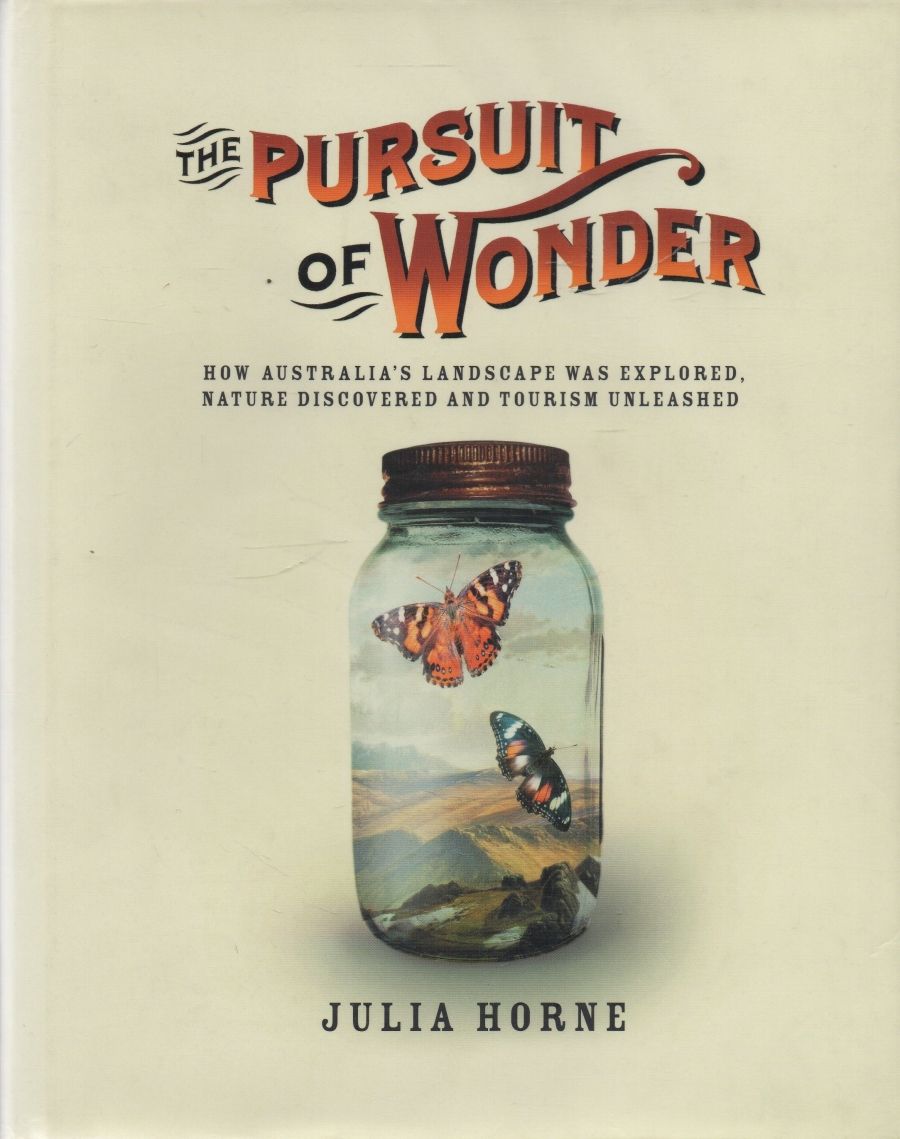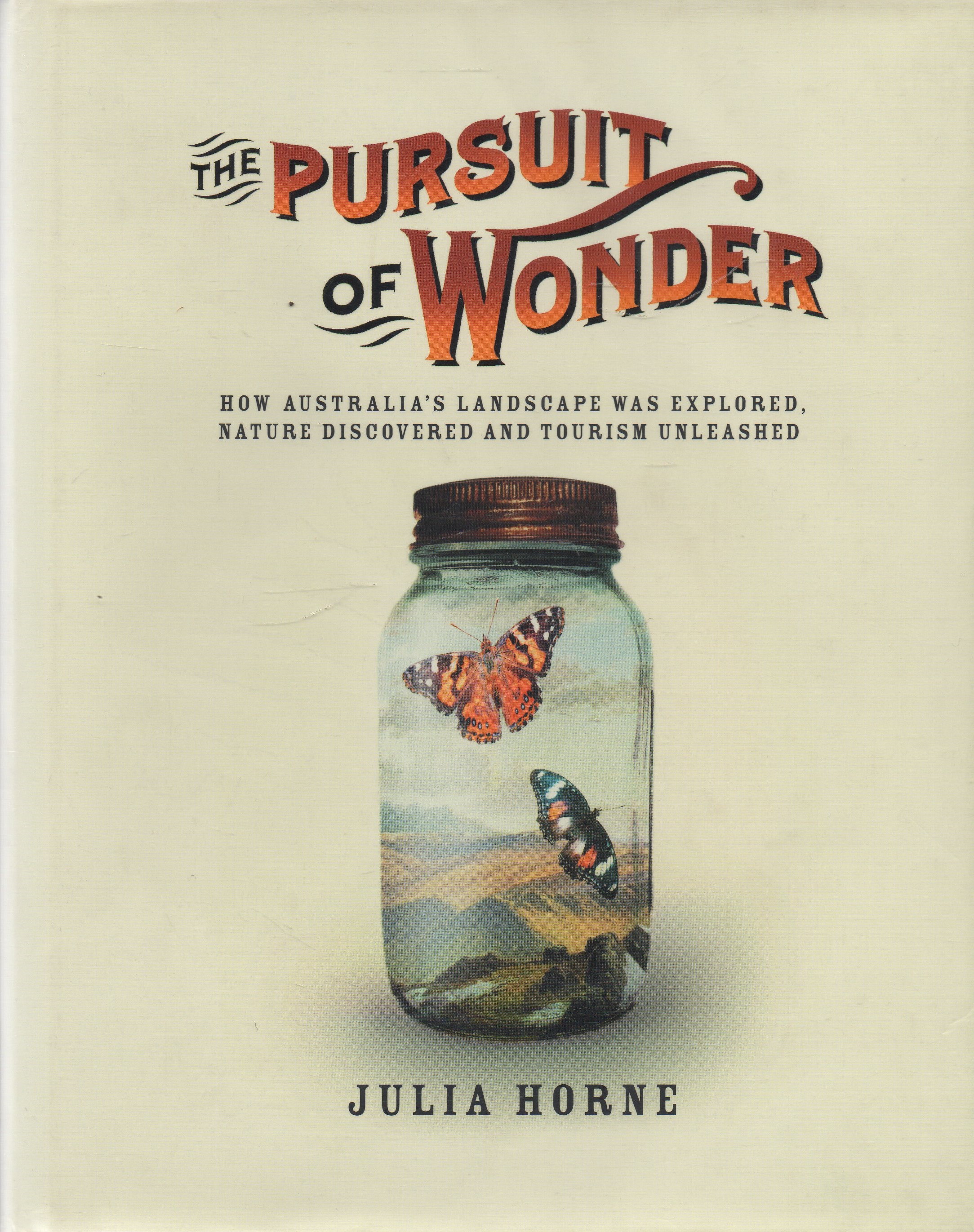
- Free Article: No
- Contents Category: Natural History
- Review Article: Yes
- Article Title: Passion for wonders
- Online Only: No
- Custom Highlight Text:
‘A crystal atmosphere reflecting a liquid blue never excelled in purity even by soft azure splendour hung over the old Venetian palaces by the magic brush of Turner, lay on the mountain tops throughout the weekend. Sunshine illumed the crags and played fantastic vagaries of colour amidst the fresh foliage, gleaming in gilded beauty on the outer fringe of fern curtains and throwing into deeper shade the bosky nooks of the laminated cliffs and mossy gorges.’
- Book 1 Title: The Pursuit of Wonder
- Book 1 Subtitle: How Australia's landscape was explored, nature discovered and tourism unleashed
- Book 1 Biblio: Miegunyah, $39.95 hb, 351 pp, 0522851665
- Book 1 Cover Small (400 x 600):

- Book 1 Cover (800 x 1200):

Why do some sights go out of fashion and others thrive? Why do thousands of weekend warriors and overseas tourists still make the pilgrimage to the Three Sisters, but not to the less spectacular mountain valleys? What motivates us in the first place to find something beautiful or wondrous? These questions are addressed in Julia Horne’s Pursuit of Wonder, a strikingly attractive book, whose copious illustrations and mixed type render homage to the souvenir viewbooks of times past.
Horne’s focus here is on the nineteenth century, whose passion for ‘wonders’ coincided with much of the physical and emotional occupation of Australia. By tracing the ‘evolution’ of its enthusiasms for ‘scenic Australia’, she aims to give a sense of why tourists were drawn to certain sights, and of the lasting social and cultural effects of their wonder. But readers hoping for a linear story will not find one. Instead, with a cultural historian’s preference for specificity over grand narrative, Horne breaks her analysis into a series of fascinating micro-histories, on such topics as the rise and fall of fern appreciation, the discovery of caves, or the establishment of mountain resorts. Each title is set out on a double-page colour spread, accompanied by a chapter précis of jaunty historicity: ‘In which a brief history of nineteenth-century travel writing is presented’, or ‘In which the attractions of Australia’s mountains are explained.’
‘Natural attractions physically exist,’ Horne writes, but ‘they are also, in a way, figments of the imagination’, shaped by intellectual traditions. Take mountains, for example. Seen as ugly and uninteresting until the mid-seventeenth century, they were still ‘dreary’ and ‘barren’ to the eyes of the late-eighteenth-century Sydneysider Watkin Tench. But once a route was established across the Blue Mountains, travellers shifted their attention to their effect on the senses. The vertiginous perspectives of artists such as Frederick Grosse would go out of fashion in the 1880s, along with the term ‘sublime’, but mountains would endure as fixtures on the tourist landscape.
Horne is particularly interested in the way that class and gender (travellers’ sense of being ‘gentlemen’ or ‘ladies’) fed into the choice and maintenance of sights as ‘wonderful’. She notes that, when male travellers became fixated on a masculine poetics of sweeping, panoramic views in the 1840s, women began taking a more ladylike interest in the delicate beauty of trickling watercourses. At the same time, travel could provide a relaxed environment for the mingling of the sexes (as long as it was understood that the men must forage for comfortable bedding for the ladies). Especially delightful examples are offered in private documents dug up by Horne: amateur sketches made in 1886 by a party of three ladies and four gentlemen of an expedition to the Jenolan Caves, and a photograph, taken in the same area in the same year, of the modest campsite of the ‘Pickwick Corresponding Club’.
I first became aware of Horne’s work in 1991. Her article in Australian Cultural History on travellers’ changing perceptions of the Blue Mountains (which forms a part of The Pursuit of Wonder) was a formative influence on my own fascination with our shifting relationship to the mountain air there in my first novel. Because of my fondness for this essay, I was disappointed that I could not enter wholeheartedly into the argument of The Pursuit of Wonder.
Horne’s decision to limit her study of wonder to the writing of the upper and middle classes has the unfortunate effect, especially in two ‘fictionalised’ chapters drawn from a range of journals and correspondence, of suggesting a pat seamlessness about the imaginary formation of our tourist landscapes – an impression that the cutely self- conscious ‘historicity’ of the book’s design reinforces. Even if our tastes for the picturesque are formed from above (and I am not sure this is the case), Horne underplays the looming ‘problem’ that the working classes presented to the nineteenth-century middle-class imagination. Their presence in the cities was an urgent motivator for the ‘change of air’ campaigns she mentions, as well as the seminal writings of critics like Ruskin, for whom culture had a crucial role in their management and moral improvement. Were these travellers so often on the same page? Surely there are also some instances of dissatisfaction or dissent on record?
I could not help comparing The Pursuit of Wonder to Martin Thomas’s extraordinary Artificial Horizon (2003), a study of the ‘dreamwork of imperialism’ that also focuses on the Blue Mountains but that stresses the ambiguity and complexity of our emotional responses – the fear, unease and guilt that can also be attendant on wonder. In contrast to the near-invisibility of indigenous Australians in The Pursuit of Wonder, Thomas argues that their presence has always figured in the white imagination of landscape, even if only in extravagant fantasies of their invisibility. Similarly, one could read encomiums about the mountains’ beauty, such as the one with which I began this review, as attempts to overcompensate for the uncanniness and weird melancholy of a landscape that did not give itself up easily to European eyes.
But it is perhaps unfair to criticise Horne’s methodology, since her book appears to be aimed less at an academic market than a literate ‘coffee table’ audience (the press release suggests it might appeal to fans of the books of Barbara Hodgson). The major achievement of The Pursuit of Wonder is in the wealth of pictorial material it brings into the light of day. Among its chief delights are etchings in the sublime mould, many by anonymous artists, of subjects such as Tasmania’s Mount Wellington and North Queensland’s waterfalls; cartoons and sketches from illustrated weeklies; impromptu sketches by artists such as George French Angas and Eugene von Guérard; photographs from private collections and guidebooks; and the delicate botanical sketches from Louisa Atkinson’s journals. Horne’s book is also valuable for its recreation of the tourist infrastructure (including hotels, walking tracks and transport) that supported the nineteenth century’s rich ecology of wonders. While The Pursuit of Wonder sometimes reduces the emotional dimensions and mystery – the very wonder – of wonder, its excitement lies in its documentation of the (white, middle-and-upper-class) imaginative effort that went into creating the sights we value as beautiful today.


Comments powered by CComment